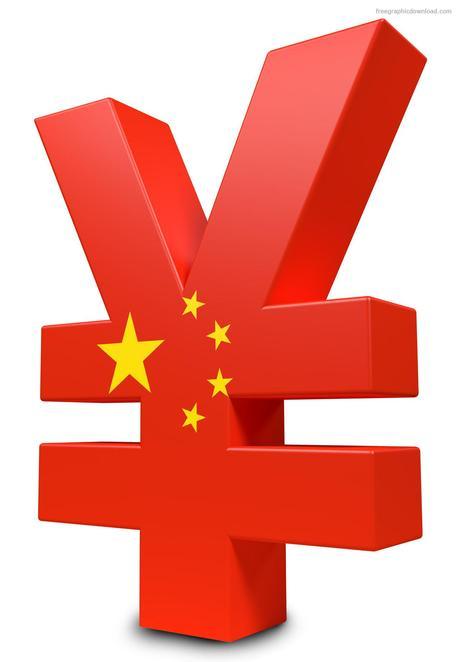
(Note: ¥uan and Waterloo of Petro$ Parts I and II combined)
Ongoing western sanctions due Ukraine are pushing China and Russia to close cooperation – the great Eurasian axis is already in motion. Despite the headlines in mainstream western media related to civil war in Ukraine the primary war is being fought monetarily. The Russia-China Strategic Partnership (RCSP) is truly global in scope, having come to encompass the entire world to varying degrees. The Ukraine War might be the U.S. Dollar Waterloo event.
As the Americans and their allies are trying to squeeze Russia and Iran with a combination of economic sanctions and political isolation, alternative poles of power are emerging that soon may present a serious challenge to the U.S.-dominated world that emerged from the end of the Cold War.
The Russian response to ongoing western sanctions has been launching a counter-strategy that could bring the cost boomeranging right back to Washington. Namely, the formation of a potential non-dollar trading block among major players in the global energy markets including Iran and China.
The end of the Petrodollar
(In 1971 Richard Nixon was forced to close the gold window taking the U.S. off the gold standard and setting into motion a massive devaluation of the U.S. dollar.In an effort to prop up the value of the dollar Nixon negotiated a deal with Saudi Arabia that in exchange for arms and protection they would denominate all future oil sales in U.S. dollars. )
For decades, virtually all oil and natural gas around the world has been bought and sold for U.S. dollars. Since World War II, America’s geopolitical supremacy has rested not only on military might, but also on the dollar’s standing as the world’s leading transactional and reserve currency.
Last year Russia produced about 10.5 million bbls. of oil per day and exported 70% of it. That amounts to nearly 2.6 billion barrels with a value of nearly $250 billion at world market prices. It also exported the equivalent of nearly 1 million barrels per day of natural gas with a market value of upwards of US$50 billion. The truth is that Russia is the largest exporter of natural gas and the second largest exporter of oil in the world. If Russia starts asking for payment in currencies other than the U.S. dollar, that will essentially end the monopoly of the petrodollar.
China just overtook the US as the world’s largest economy. The US national debt is now past €17 trillion. China – their biggest creditor – has been cutting on US debt holdings and hoarding gold on the side to be prepared for the possible collapse of the dollar. The US federal government ran an estimated budget deficit of $486 billion, or 2.8 per cent of GDP, in fiscal year 2014. By contrast, Russia just posted a federal budget surplus of 2 per cent of GDP.
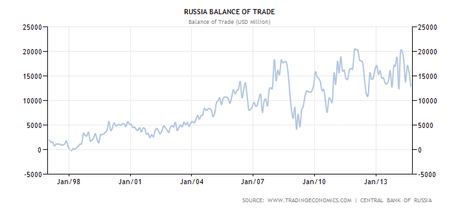
Russia recorded a trade surplus of 15700 USD Million in September of 2014. Balance of Trade in Russia averaged 8925.26 USD Million from 1997 until 2014, reaching an all time high of 20356 USD Million in January of 2012 and a record low of -185 USD Million in February of 1998. (Source: Trading Economics )

The largest natural gas producer on the planet, Gazprom, has signed agreements with some of their biggest customers to switch payments for natural gas from U.S. dollars to euros. If other nations start following suit – start trading a lot of oil and natural gas for currencies other than the U.S.$ – that will be a massive blow for the petrodollar, and it could end up dramatically changing the global economic landscape.
Moscow, allied with the BRICS, is actively working to bypass the US dollar. The core point is that Russia is not alone. Besides the BRICS also the G-77, the Non-Aligned Movement (NAM), the whole Global South is critical to U.S. led bullying and would like to have other alternative in international relations. This past summer, the BRICS countries created an alternative to the largely U.S.-controlled World Bank and International Monetary Fund (IMF), and the Shanghai Cooperation Organization (SCO) added 1.6 billion people to its rolls.
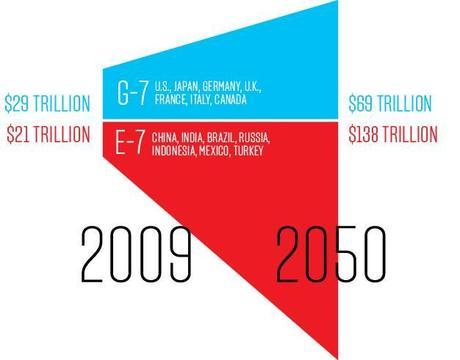
Back in 1971, it was necessary to assure that the dollar would retain its position in world trade as the world’s premiere currency, in spite of the fact that it was no longer backed by anything. The U.S. reached an agreement with Saudi Arabia that, in trade for arms and protection, the Saudis would denominate all future oil sales, worldwide, in dollars. The other OPEC countries fell into line, and the “petrodollar” was assured.
Now the Sino-Russian cooperation is challenging the Americans, and there are many countries that would be happy to join them in dethroning the US dollar as the world’s reserve currency. The historic gas deal between Russia and China is very bad news for the petrodollar – it might be start of the “de-Americanised” world.
¥uan replacing the Petrodollar
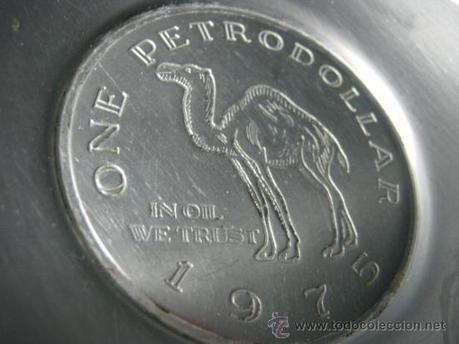
“Over the last few weeks there has been a significant interest in the market from large Russian corporations to start using various products in renminbi and other Asian currencies, and to set up accounts in Asian locations,” Pavel Teplukhin, head of Deutsche Bank in Russia, told the Financial Times, The renminbi is the official currency of the People’s Republic of China. literally means “people’s currency”. The yuan is the basic unit of the renminbi, but is also used to refer to the Chinese currency generally, especially in international contexts.
Moving the yuan towards internationalisation involves three distinct phases: turning the Chinese currency into a) a trading currency, b) an investment currency, and c) a reserve currency.
Some recent developments:
- Chinese credit rating agency Dagong has downgraded U.S. debt from A to A- and has indicated that further downgrades are possible.
- China has just entered into a very large currency swap agreement with the eurozone that is considered a huge step toward establishing the yuan as a major world currency.
- Back in June 2014, China signed a major currency swap agreement with the United Kingdom. This was another very important step toward internationalizing the yuan.
- China currently owns about 1.3 trillion dollars of U.S. debt, and this enormous exposure to U.S. debt is starting to become a major political issue within China.
- Mei Xinyu, Commerce Minister adviser to the Chinese government, warned (on Oct 2014) China may decide to completely stop buying U.S. Treasury bonds.
China is the largest producer of gold in the world, and it has also been importing an absolutely massive amount of gold from other nations and in addition China plans to buy another 5,000 tons of gold.) There are many that are convinced that China eventually plans to back the yuan with gold and try to make it the number one alternative to the U.S. dollar.
If China does decide to back the yuan with gold and no longer use the U.S. dollar in international trade, it will have devastating effects on the U.S. economy. If other nations stopped using the dollar to trade with one another, the value of the dollar would plummet dramatically. One could claim that the entire way of life in U.S. depends on the U.S.$ being the primary reserve currency of the world. (Source: The Economic Collapse )
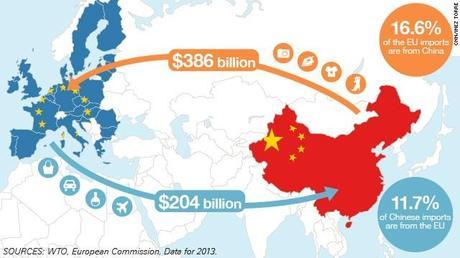
The dollar does not just predominate in China’s trade with the United States, but with other countries as well. The first steps towards the internationalisation of the yuan emerged in 2008-2009. At that time, businesses and companies were allowed to use the yuan in trade with Hong Kong (Xianggang), Macau, and ASEAN countries. In 2012, every Chinese company with a license for export and import transactions was able to use the yuan. An active transition to foreign trade settlements in yuan is happening alongside an increase in the use of the national currencies of China’s trading partners. This is being facilitated by the signing of bilateral currency swaps between the People’s Bank of China (PBC) and the central banks of China’s trading partners. To date, the PBC has signed more than 20 currency swap agreements. At the end of 2013-beginning of 2014, the yuan overtook the euro in terms of the amount of payments used for international trade, and took second place after the US dollar. According to the People’s Bank of China (PBC) , there was more than 1.3 trillion yuan overseas at the end of 2013, which is equivalent to approximately US $250 billion. In fact, this money is forming an offshore yuan market. At present, the yuan can be directly converted with the US dollar, the Japanese yen, the Australian dollar, the Russian rouble, the Malaysian ringgit, and the New Zealand dollar. The latest such agreement was signed between China and New Zealand in March 2014. (Source: Strategic Culture Foundation )
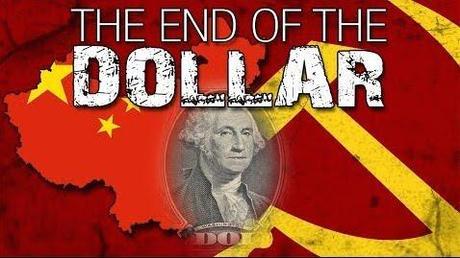
Bypassing the U.S. dollar system is a spear-head of Russia’s counter-offensive. Besides monetary war the emergencing cooperation on different pro-Russian fields and energy policy are linked to ongoing geopolitical turmoil.The wider picture includes the Sino-Russian cooperation, the BRICS, the SCO, the EEU, the energy war and other bilateral operations.
The Sino-Russian cooperation
The Russia-China strategic partnership will keep evolving very fast – with Beijing in symbiosis with Moscow’s immense natural and military-technological resources. Not to mention the strategic benefits. Faced with an increasingly hostile West, Russia is visibly turning East. In particular, China and Russia have become closer, signing a historic gas deal, conducting joint naval exercises, and increasing trade.
Gazprom signed a thirty-year gas contract worth $400 billion. The deal’s importance can be compared with a similar accord concluded in the 1960s that brought Russian gas to West Germany for the first time. Moscow and Beijing vow to more than double their bilateral trade to $200 billion by 2020, that is, roughly half of their current turnover with the EU.
It is clear that Moscow seeks an acceleration of its business ties with China. On Nov. 09, 2014 President Vladimir Putin and Chinese leader Xi Jinping signed a memorandum of understanding on the so-called “western” gas supplies route to China. Russia’s so-called “western” or “Altay” route would supply 30 billion cubic meters (bcm) of gas a year to China. The new supply line comes in addition to the “eastern” route, through the “Power of Siberia” pipeline, which will annually deliver 38 bcm of gas to China. Work on that pipeline route has already begun after a $400 billion deal was clinched in May. Among the business issues discussed by Putin and Xi at their fifth meeting this year was the possibility of payment in Chinese yuan, including for defense deals military, Russian presidential spokesman Dmitry Peskov was cited as saying by RIA Novosti. (Source: RT )
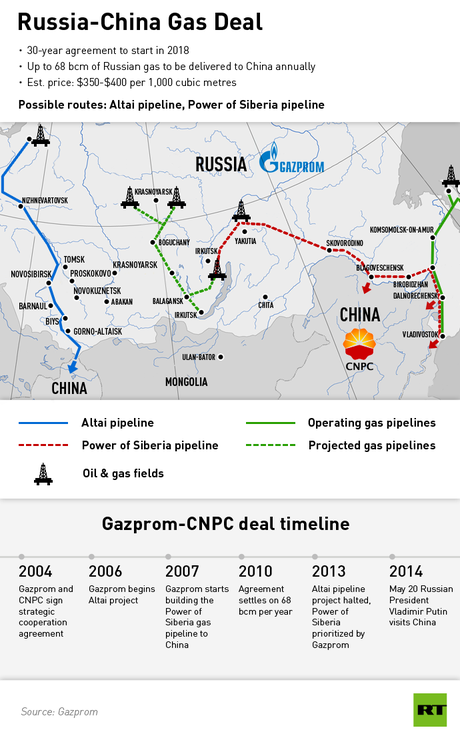
In addition China and Russia have agreed to jointly build a seaport on the coast of the sea of Japan, which are projected to become one of the largest on the coast in North-East Asia. The facility will be located in our territory and will serve up to 60 million tons of cargo per year.
Also, China has decided to invest 400 billion rubles in the construction of high-speed highway Moscow-Kazan, which is part of transport corridor Moscow-Beijing.
Russia and China are determined to reduce U.S. and North Atlantic Treaty Organization (NATO) presence in Central Asia to what it was before the 2001 invasion of Afghanistan. The SCO has consistently rebuffed U.S. requests for observer status, and has pressured countries in the region to end U.S. basing rights. The United States was forced out of Karshi-Khanabad in Uzbekistan in 2005, and from Manas in Kyrgyzstan in 2014.
“At present, the SCO has started to counterbalance NATO’s role in Asia,” says Aleksey Maslov, chair of the Department of Asian Studies of the Higher School of Economics in Moscow. And the new members, he says, want in to safeguard their interests. (Source: VoR)
China overtook Germany as Russia’s largest trading partner in 2011, Last year, China acquired 12.5 percent of Russia’s Uralkali (URKA:RM), the biggest producer of potash in the world, and China National Petroleum agreed to prepay Rosneft (ROSN:RM), run by Putin associate Igor Sechin, about $70 billion as part of a $270 billion, 25-year supply deal. That was followed by Rosneft’s $85 billion, 10-year accord with China Sinopec and China National Petroleum’s purchase of 20 percent of an Arctic gas project from Novatek for an undisclosed sum. (Source: Bloomberg Businessweek )
The BRICS
The BRICS met 2013 in Durban, South Africa, to, among other steps, create their own credit rating agency, sidelining the “biased agendas” of the Moody’s/Standard & Poor’s variety. They endorsed plans to create a joint foreign exchange reserves pool. Initially it will include US$100 billion. It’s called a self-managed contingent reserve arrangement (CRA). 
During the July (2014) BRICS Summit in Brazil the five members agreed to directly confront the West’s institutional economic dominance. The BRICS agreed to establish the New Development Bank (NDB) based in Shanghai , pushed especially by India and Brazil, a concrete alternative to the Western-dominated World Bank and the Bretton Woods system. With initial authorized capital of $100 billion, including $50 billion of equally shared initial subscribed capital, it will become one of the largest multilateral financial development institutions. Importantly, it will be open for other countries to join.
In addition creation of the Contingent Reserve Arrangement, or currency reserve pool, initially sized at $100 billion, will help protect the BRICS countries against short-term liquidity pressures and international financial shocks. Together with the NDB these new instruments will contribute to further co-operation on macroeconomic policies. According Conn Hallinan – in his article Move Over, NATO and IMF: Eurasia Is Coming – The BRICS’ construction of a Contingent Reserve Arrangement will give its members emergency access to foreign currency, which might eventually dethrone the dollar as the world’s reserve currency. The creation of a development bank will make it possible to bypass the IMF for balance-of-payment loans, thus avoiding the organization’s onerous austerity requirements.
Also it was agreed MoU’s among BRICS Export Credit and Guarantees Agencies, as well as the Cooperation Agreement on Innovation within the BRICS Interbank Cooperation Mechanism, which will offer new channels of support for trade and financial ties between the five countries.
So in near future BRICS will be trading in their own currencies, including a globally convertible yuan, further away from the US dollar and the petrodollar. All these actions are strenghtening financial stability of BRICS – a some kind of safety net precaution, an extra line of defense.
Emerging economic powers such as China, India and Brazil have long been demanding greater share of votes in multilateral development institutions like the World Bank, International Monetary Fund and the Asian Development Bank (ADP) to reflect their recent phenomenal growth. China’s economy is expected to grow to $10 trillion this year, yet its share of votes in the Bretton Woods institutions is only 3.72 percent, compared with 17.4 percent for the United States. The signing ceremony of the Memorandum of Understanding on Establishing Asian Infrastructure Investment Bank (AIIB) took place in Beijing, Oct. 24, 2014 According to ADB, in the 10 years up to 2020, the region requires investments of $8 trillion in terms of national infrastructure, or $800 billion a year. The ADB currently lends out only about 1.5 percent of this amount. The AIIB is expected to have an initial capital base of $100 billion. The AIIB, to begin with, will serve at least five objectives for China. First, it could help China invest part of its foreign exchange reserves of $3.9 trillion on commercial terms. Second, it will play a vital role in the internationalization of the yuan. And fifth, the AIIB will boost China’s global influence and enhance its soft power.
BRICS could be expanded to include the MINT countries (MINT is an acronym referring to the economies of Mexico, Indonesia, Nigeria, and Turkey.), thus furthering the organization’s scope and creating opportunities for a long-term strategic ‘flip’ of those states from their largely Western orientations.
Being in the same organization does not automatically translate into having the same politics on international questions. The BRICS and the recent Gaza conflict are a good example. China called for negotiations; Russia was generally neutral, but slightly friendly toward Israel; India was silent (Israel is New Delhi’s number-one source of arms); South Africa was critical of Israel, and Brazil withdrew its ambassador.
As Russia is taking over the position of the BRICS Chair, the next summit will be held in the city of Ufa in the Republic of Bashkortostan, in July 2015.
The SCO
The Shanghai Cooperation Organization (SCO) is the cradle in which the Russian-Chinese strategic partnership (RCSP) was born and raised. Originally founded as the Shanghai Five in 1996, it was reformed as the SCO in 2001 with the inclusion of Uzbekistan. Less than a month after the BRICS’ declaration of independence from the current strictures of world finance, the SCO—which includes China, Russia, Kazakhstan, Kyrgyzstan, Tajikistan, and Uzbekistan—approved India, Pakistan, Iran, and Mongolia for membership in the organization. Also SCO has received applications for the status of observers from Armenia, Azerbaijan, Bangladesh, Belarus, Nepal and Sri Lanka.
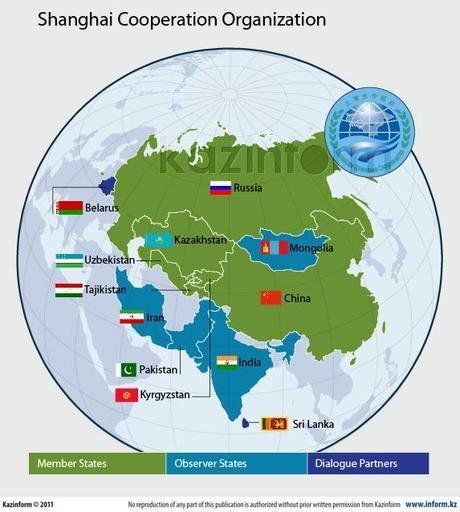
It was the single largest expansion of the economic cooperation and security-minded group in its history, and it could end up diluting the impact of sanctions currently plaguing Moscow over the Ukraine crisis and Tehran over its nuclear program. These countries directly fall into the immediate sphere of the RCSP, where either Russia or China can exert some degree or another of important influence to varying degrees. Also, the SCO sets out the foundations of the RCSP, listing the fight against “terrorism, separatism, and extremism in all their manifestations” (thus including Color Revolutions) as their foremost foe. It just so happens that the U.S. engages in all of these activities in its Eurasian-wide campaign of chaos and control, thereby placing it at existential odds with Russia and China, as well as the other official members. Even before the recent additions, SCO represented three-fifths of Eurasia and 25 percent of the world’s population.
For Iran, SCO membership may serve as a way to bypass the sanctions currently pounding the Iranian economy. Russia and Iran signed a memorandum in August (2014) to exchange Russian energy technology and food for Iranian oil, a move that would violate U.S. sanctions. One particular constraint is Russia’s important relationship with Israel, which Moscow will not give up unless Jerusalem drops its neutral stance and joins the U.S.-led condemnation of Russia.
Chinese President Xi Jinping has also promoted new regional security initiatives. In addition to the already existing Shanghai Cooperation Organization, a Chinese-led security institution that includes Russia and four Central Asian states, Xi wants to build a new Asia-Pacific security structure that would exclude the United States.
As for India and Pakistan energy is a major concern the membership in the oil- and gas-rich SCO is quite reasonable. Whether that will lead to a reduction of tensions between New Delhi and Islamabad over Kashmir remains to see, but at least the two traditional enemies will be in same organization to talk about economic cooperation and regional security on a regular basis.
As joint forum the SCO can ease tensions in Central Asia e.g. between SCO members Uzbekistan and Kyrgyzstan over borders, and both countries, plus Tajikistan, over water rights. Most SCO members are concerned about security, particularly given the imminent departure of the United States and NATO from Afghanistan. That country might well descend into civil war, one that could have a destabilizing effect on its neighbors. From August 24 -29, SCO members China, Russia, Kazakhstan, Kyrgyzstan, and Tajikistan took part in “Peace Mission 2014,” an anti-terrorist exercise to “subdue” a hypothetical Central Asian city that had become a center for terrorist activity.
The BRICS and the SCO are the two largest independent international organizations to develop over the past decade. There is also other developments to reduce old U.S. global dominance. The newly minted Union of South American Nations (USAN) includes every country in South America, including Cuba, and has largely replaced the Organization of American States (OAS), a Cold War relic that excluded Havana. While the United States and Canada are part of the OAS, they were not invited to join USAN.
Eurasian Economic Union (EEU)
Eurasian integration has moved to a higher level, to replace the EurAsEC came a new form of closer Association of the Eurasian Economic Union (EEU) also known as the Eurasian Union (EAU). To him by the old member States (Russia, Kazakhstan, Belarus) was joined by Armenia, the next candidate in the list on the accession of Kyrgyzstan, and later, his desire to join the EAEC expressed and Vietnam. Also the accession of Turkey and Syria are on the way.
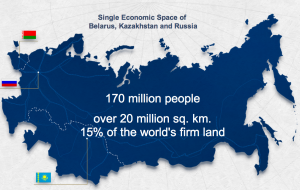
Moldova, Ukraine and Georgia have been offered by both the European Union and the Eurasian Economic Union to join their integration unions. All three countries opted for the European Union by signing association agreements on March 21, 2014. However break-away regions of Moldova (Transnistria), Ukraine (Republic of Donetsk) and Georgia (South Ossetia and Abkhazia) have expressed a desire to join the Eurasian Customs Union and integrate into the Eurasian Economic Union.
Putin is scheduled to visit Japan later in 2014 in an effort to keep Russia’s technology and investment channel to the country open. And Moscow is expected to reinvigorate ties with India, particularly in the defense technology sphere, under the leadership of newly elected Prime Minister Narendra Modi.
The Eurasian union may become an add-on to, or even an extension of, China’s Silk Road project – a common space for economic and humanitarian cooperation stretching all the way from the Atlantic to the Pacific Ocean
Treaties and development stages of Eurasian Economic Union/Structural evolution
1991
1996
2000
1995- 2007
2007 & 2011
2014
Eurasian Economic Union (EEU)
Eurasian Economic Space
Eurasian Customs Union (ECU)
Eurasian Economic Community (EurAsEC)
Increased Integration in the Economic and Humanitarian Fields
Commonwealth of Independent States (CIS)
Other bilateral development
Russia is in the process of politically and economically integrating with Kazakhstan and soon Kyrgyzstan under the auspices of the Eurasian Union, and it has mutual security commitments with Kazakhstan, Kyrgyzstan, and Tajikistan under the Collective Security Treaty Organization (CSTO). China, on the other hand, is more of a soft leader in Central Asia, having established lucrative business contacts in recent years and struck extremely strategic energy deals with most of the region’s members, first and foremost Turkmenistan.
A Russian-Iranian strategic partnership would extend beyond Caspian and nuclear energy issues and see implicit cooperation between the two in the Mideast, especially in Syria, Iraq, and Yemen. It can even carry over into Afghanistan after the NATO drawdown by year’s end. This can help to build an alternative non-Western-centric trade network that can bolster Russia’s complex economic interdependence with other states. This would give it the opportunity to expand mutual relations beyond the economic sphere and perhaps eventually associate these states into the multilateral webs of BRICS and the SCO.
Russia is also pursuing bilateral relations with Iran with fewer constraints. This refers to nuclear energy, oil and gas, and arms deals, all based on pragmatic considerations: a Russo-Persian alliance is unlikely in view of many differences between Moscow and Tehran and thick layers of mutual suspicion.
At the recent summit of the SCO in Dushanbe (11-12 Sep. 2014 )the cooperation with SCO-applicant Iran went wider. Some of the projects were following:
- The well-known “Uralvagonzavod”, began talks with Iran on the supply of freight cars 40 billion annually.
- Interestingly, Iran is not on the camera, discussing terms of oil supplies in exchange for electricity, in which Russia plans to build in Iran, the network of hydro – and thermal power plants.
- Iran and Russia have made progress towards an oil-for-goods deal sources said would be worth up to $20 billion, which would enable Tehran to boost vital energy exports in defiance of Western sanctions. In January Reuters reported Moscow and Tehran were discussing a barter deal that would see Moscow buy up to 500,000 barrels a day of Iranian oil in exchange for Russian equipment and goods.
(Source: EN.XPPX.org )
One particular constraint is Russia’s important relationship with Israel, which Moscow will not give up unless Jerusalem drops its neutral stance and joins the U.S.-led condemnation of Russia.
Putin is scheduled to visit Japan later in 2014 in an effort to keep Russia’s technology and investment channel to the country open. Russia is interested in restarting talks to build a natural gas pipeline between its Sakhalin Island and Japan’s far northern island of Hokkaido, Russia already supplies 9.8 percent of Japan’s LNG imports. The proposed pipeline would deliver 20 billion cubic meters of natural gas every year, which at full capacity would supply 17 percent of Japan’s total natural gas imports. As an additional bonus, using a pipeline does not require the building of expensive regasification plants and natural gas from Russia would probably still be relatively cheap. This is also part of Moscow’s attempt to balance its interests and expand its energy influence eastward.
Also Moscow is expected to reinvigorate ties with India, particularly in the defense technology sphere, under the leadership of newly elected Prime Minister Narendra Modi.

While Russia is consolidating its influence over the former Soviet sphere with states which it already has cultivated deep relations with, China is moving in due its strategic interest in Central Asia. For China a top priority is to be able to diversify its natural resource import routes in order to avoid the U.S. dominated Straits of Malacca.
The growing influence of China in Southeast and East Asia and the Indian Ocean is explained with “string of pearls” concept (strategic points such as Hainan Island, the Woody Islands/close to Vietnam, Chittagong/Bangladesh, Sittue and the Coco Islands/Myanmar, Hambantota/Sri Lanka etc.). The “string of pearls” strategy is aimed at protecting China’s oil flows, affirming the country as a global naval power with diverse interests throughout the world, and overcoming attempts by the USA to cut off access to or from China via the world’s oceans. Furthermore, an important task lay in minimizing potential threats in the most complex and vulnerable choke point at the junction of two oceans, named the “Malacca Dilemma”. (Source and more in Second Wind for China’s String of Pearls Strategy by Nina Lebedeva ).
Tehran is reaching out to Beijing as well. Iran and China have negotiated a deal to trade Iran’s oil for China’s manufactured goods. Beijing is currently Iran’s number-one customer for oil. In late September, two Chinese warships paid a first-ever visit to Iran, and the two countries’ navies carried out joint anti-piracy and rescue maneuvers.
Importing more gas from Russia helps Beijing to gradually escape its Malacca and Hormuz dilemma and industrialize the immense, highly populated and heavily dependent on agriculture interior provinces.
The Northern East-West Freight Corridor (Eurasian Landbridge) is an idea to link the Far East and Europe by rail takes its origin with the construction of the Trans Siberian railway linking Moscow to Vladivostok, completed in 1916. With a length of 9,200 km it is the longest rail segment in the world. It was initially used solely as an inland rail link, but in the 1960s the Soviet Union started offering a landbridge service from Vladivostok using the Trans Siberian to reach Western Europe.
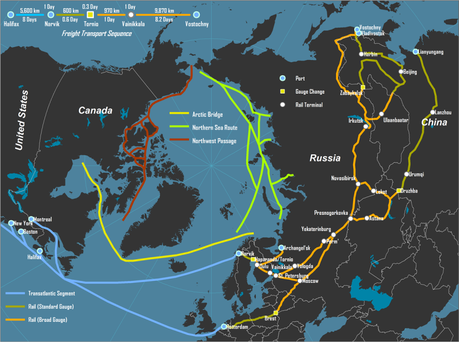
Energy war
U.S. ally inside OPEC, the kingdom of Saudi Arabia, has been flooding the market with deep discounted oil, triggering a price war within OPEC, with Iran following suit and panic selling short in oil futures markets. The Saudis are targeting sales to Asia for the discounts and in particular, its major Asian customer, China where it is reportedly offering its crude for a mere $50 to $60 a barrel rather than the earlier price of around $100. When combined with the financial losses of Russian state natural gas sales to Ukraine and prospects of a US-instigated cutoff of the transit of Russian gas to the huge EU market this winter as EU stockpiles become low, the pressure on oil prices hits Moscow doubly. More than 50% of Russian state revenue comes from its export sales of oil and gas. The US-Saudi oil price manipulation is aimed at destabilizing several strong opponents of U.S. globalist policies. Targets include Iran and Syria, both allies of Russia in opposing a US sole Superpower. In fact the oil weapon is accelerating recent Russian moves to focus its economic power on national interests and lessen dependence on the Dollar system. If the dollar ceases being the currency of world trade, especially oil trade, the US Treasury faces financial catastrophe.
The shale gas revolution and a greater availability of LNG technologies, EU regulatory initiatives and implementation of the Third Energy Package provisions play a key role in transformations of gas markets.

In July 2011, the governments of Syria, Iran and Iraq signed an historic gas pipeline energy agreement which went largely unnoticed in the midst of the NATO-Saudi-Qatari war to remove Assad. The pipeline, envisioned to cost $10 billion and take three years to complete, would run from the Iranian Port Assalouyeh near the South Pars gas field in the Persian Gulf, to Damascus in Syria via Iraq territory. The agreement would make Syria the center of assembly and production in conjunction with the reserves of Lebanon. This is a geopolitically strategic space that geographically opens for the first time, extending from Iran to Iraq, Syria and Lebanon. As Asia Times correspondent Pepe Escobar put it, “The Iran-Iraq-Syria pipeline – if it’s ever built – would solidify a predominantly Shi’ite axis through an economic, steel umbilical cord.”
In ongoing oil war the U.S. shale oil producers will suffer most. According to experts’ estimates, the cost of production is around 80-90 dollars a barrel, 4-5 times more than the traditional oil. It means that the current price – 85 dollars a barrel as of October 17 – makes the companies operate in the red. Some producers will have to suspend operations facing mass bankruptcy in case the oil price falls lower than 80 dollars as shareholders start getting rid of zero profit bonds. The shale oil «soap bubble» will blow like the housing construction industry «bubble» blew in 2008. Of course, as time goes by oil prices will go up but it’ll be a different world with some US oil producers non-existent anymore…
Russia insists the South Stream project should be exempt from the effect of the Third Energy Package because it signed bilateral inter-governmental agreements with the EU countries participating in the construction of the gas pipeline on their territory before the EU’s new energy legislation came into force. Therefore, Russia says that the European Commission’s requirement to adapt these documents to the Third Energy Package contradicts the basic law principle that legislation cannot have retroactive force. The Third Energy Package requires, in particular, that a half of the capacities of the pipeline built with Russian money must be reserved for independent suppliers, i.e. for cheap and free transit of Caspian gas to Europe independently from Russia. Therefore, Russia does not recognize the legitimacy of applying the Third Energy Package to the South Stream gas pipeline project.
Bottom line
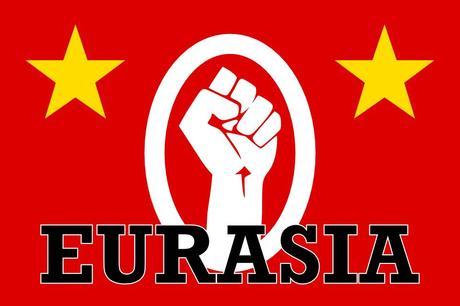
The geopolitical situation is now transforming from traditional Sino-U.S. relations to U.S.-China-Russia triangle in which China, rather than the United States, will be the central player.
In addition the EU is worried that Russia will turn east and Europe will lose much of its Russian market share. At a time when the euro area threatens to collapse, where an acute economic crisis has led the U.S. into a debt of up to 14 940 billion, and where their influence is dwindling in the face of the emerging BRICS powers, it becomes clear that the key to economic success and political domination lies mainly in the control of the energy source of the century: gas.
With China signing the natural gas deal with Russia and the president of China publicly stating that it’s time to create a new security model for the Asian nations that includes Russia and Iran, it’s clear China has chosen Russia over the U.S. Today the US-backed wars in Ukraine and in Syria are but two fronts in the same strategic war to cripple Russia and China and to rupture any Eurasian counter-pole to a U.S.-controlled regions. In each, control of energy pipelines, this time primarily of natural gas pipelines—from Russia to the EU via Ukraine and from Iran and Syria to the EU via Syria—is the strategic goal.
So far U.S. has bullied its way around smaller nations for too long now. It seems to me that finally there is coming to be a coalition of new axis with Eurasia and China. Russia and China are leading of developing a network of “parallel structures” to existing international organizations and institutions. The end goal is create an alternative reality for international engagement, so that China can expand its own influence while escaping the restrictions of the current U.S.-dominated system.
In my conclusion the era when the IMF, World Bank, and U.S. Treasury could essentially dictate international finances and intimidate or crush opponents with sanctions, pressure and threads are drawing to a close – the BRICS and the Shanghai Cooperation Organization are two nails in that coffin. These independent poles (BRICS, SCO, USAN) are developing fast and it remains to see what their ultimate impact on international politics will be – my scenario is that the impact will be a drastic shift from U.S. dominance to more balanced juxtaposition of U.S. and Eurasia.


